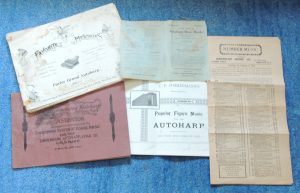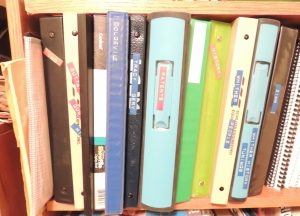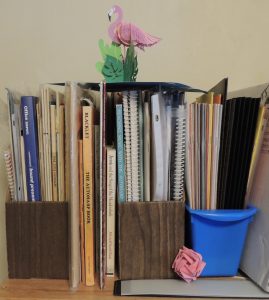On the Research Trail

An “arial view” of my autoharp research notebooks; as you can see, many are full. And there’s more in my PC!
I Am Still on the Hunt for Autoharp Instruction Books!
[one_half] [/one_half] [one_half_last]November, 11, 2022: I remain on the lookout for all kinds of autoharp materials, old and new, relating to history and to autoharpING (how it’s played). I never meant for “old autoharp paper” to become an obsession but it began to crank around April 2018. (See left; the oldest piece, bottom center, is a photocopy of a book published around 1888; I’ve since received a photocopy–better than nothing!–of an 1885 book, along with an original pamphlet from circa October 1886.)[/one_half_last]
[/one_half] [one_half_last]November, 11, 2022: I remain on the lookout for all kinds of autoharp materials, old and new, relating to history and to autoharpING (how it’s played). I never meant for “old autoharp paper” to become an obsession but it began to crank around April 2018. (See left; the oldest piece, bottom center, is a photocopy of a book published around 1888; I’ve since received a photocopy–better than nothing!–of an 1885 book, along with an original pamphlet from circa October 1886.)[/one_half_last]
On October 4, 2018, I also began to generate what is (as of the date I’m updating this page) a 750-page autoharpING timeline comprising mostly quotes from over 100 instruction books published from 1885 to 2020. The timeline, broken into seven separate documents because it got too large, include autoharp set-up, structural details to autoharps and how they evolve, picks, techniques, how people think about playing, just about anything that contributes to (and detracts from!) playing the autoharp. There are more books out there that I don’t have whose information I would like to account for in the timeline.
To find out all I could about autoharpING (autoharps themselves are already well covered; books are really more telling, especially when they are dated), I asked, for example, a few autoharping friends if they owned a particular title I was looking for. All of them had thrown that title away! Yikes! I could have used one for reference, if only they (and I) had known sooner.
[two_third]So a friend, student and autoharp collector, Charles Levy, emailed me on September 7, 2018 with, “Why don’t you compile a list so people can see what you have and know what you’re looking for?” Great idea! Then: gulp! How many books were in my stash at that time, and how many more might I acquire, in addition to catalogs, magazines, ads, etc.? I didn’t know, but I trudged forward on Charles’ idea. That turned out to be a good thing, because at that time, my “library stack” held about 25 titles. As of November 11, 2022, that number has swelled to hundreds and my “little” archives list is now a kind of library catalog system as well! Had I decided to log all of that today, well, I probably wouldn’t. (Thank you, Charles, for inspiring simple maintenance!) Then, on November 10, 2022, I hit another level of anxiety: trying to figure out where to look for any of the old autoharp pieces. The collection is big enough now that it’s easy to forget. After about 18 hours, every piece is accounted for–until next week, anyway.
Scroll down for “the rest of the story”![/two_third] [one_third_last]
Here is about 1/4 of my chronologically arranged autoharp-instruction-book collection (1947-present), complete with laser-cut guard flamingo (courtesy of autoharpist Patricia Gilbert). Under the pink origami rose are “bookmarks”: I set one in the stack when I remove a book to know where to return it. The more fragile books, magazines, autoharp sheet music and related materials before 1947 lay flat in four large, hand-made boxes (thank you, Dollar Tree), covered and nestled in clear, acid-free envelopes.[/one_third_last]
I do my best to keep expenses down on book/magazine/catalog/ad purchases as a starving artist and now a starving Accidental AutoharpING Historian (a.k.a. AAH!), but sometimes it doesn’t work out. Once upon a time I hired a professional researcher in the Washington, D.C. area to scan an out-of-print book that only the Library of Congress seems to have. The researcher did a great job, but at a price tag of just over $100 for time, travel and scanning a 36-page book (plus a hamburger for lunch?), wow, even I did save over $1000 to fly to D.C. and scan it myself! (In June 2022, I went to the Library of Congress myself and spent a full day scanning eight autoharp books and most of a piano-tuning book from the 1870s for the price of a thumb drive. Ain’t technology grand?!)
I took another hit a month later, paying $48 to the New York City Public Library for just nine pages I needed to complete a partial photocopy of an 1893 autoharp catalog that a university archives holding the same piece did not have (grrrr). All this to say that research is sometimes expensive in addition to being time-consuming! So, dear autoharpist, before you toss that book you no longer need into the circular file or give it away, no matter how old or insignificant you think it might be...
Consider donating that book to the cause of autoharp and autoharpING research.* Click here to see the Archives List (page 1 explains how everything is arranged). The List is updated periodically as more materials come in (the date at the end of the file title shows when it was last updated, as well as on page 1). On the other hand, if you’ve got a really old book you prefer to keep that I don’t have, I’ll be happy to have a scan or photocopy.
*Big, big thank yous to Jim Hill, Paul Ranney (over and over!), Eileen Roys, Charles Levy, Mike Fenton, Robin Anderson, June Fessenden, Nancy Hay, Louise and Ted McClure, Marc Tan Creti, Meg Peterson, Steve Braden, Richard Switzer, Midori Hall, Rick Meyers, Vicki Mann, Nan Bovingdon, Rene St. Aubin, Hilary Robinson, Lawana Beard, Wendy Meredith, Charles Snyder, Chuck Daniels, Dave Engels, Carole Outwater, Bill Bryant and Dean Guymon–so far!
What’s the upshot of all this? I’m finding out that a good deal of autoharp history recorded in the 1980s is now shifting in other directions, like the origins of Charles F. Zimmermann’s Figure Music, when certain autoharps came on the market (earlier or later than previously believed), the non-disappearance of the autoharp from 1900-1908, when a technique called the pinch was invented and by whom, what a “handrest” is, why the pitch D# wound up on the first chromatic autoharps when their chords didn’t use it, a real live process for transforming a chromatic autoharp to single-key diatonic, and four areas that every autoharpist needs to straighten out to play the autoharp well and with a whole lot less effort than many think. And that’s just a little bit of the whole enchilada!
My email address appears at the top of each page of the Archives List (take the spaces out and change “at” and “dot” to the usual characters to send your message) to let me know what you have.
In the name of autoharp history, I thank you in advance for your help in an attempt to land the autoharp more squarely on the musical-instruments map and benefit autoharpists and listeners everywhere. Lucille Reilly

Spine view of all of my research notebooks, including yet more contents in the two large envelopes at far left.

